
Frederick Sommer, Max Ernst, 1946, gelatin silver print, printed 1970s, National Gallery of Art, Pepita Milmore Memorial Fund. © Frederick & Frances Sommer Foundation
Sommer did not expressly identify himself with the surrealist movement, though he exhibited with its members several times. Nevertheless, his work reveals that from the late 1930s he was interested in many of the same themes and approaches that the surrealists had begun to explore in the 1920s. The Sommers first met Max Ernst (1891–1976), a prolific surrealist, in 1941 in Los Angeles after Ernst came to the United States fleeing World War II. The friendship deepened after Ernst and his wife, Dorothea Tanning, came to visit the Sommers in 1943 and moved to Sedona, Arizona in 1946. In 1944, thanks to Ernst, Sommer’s drawings and photographs were published in the fourth and last issue of VVV, a short-lived but influential journal of the surrealists in America.
Though the friendship grew out of already shared sensibilities, Ernst’s presence encouraged Sommer to pursue surrealist images and techniques of automatism and free association. Sommer’s photographs from the late 1940s and early 1950s explored new ways to surprise and unsettle viewers. Though disagreeing with the surrealists’ aims of accessing psychic realms that lie beyond rational thought, Sommer wrote in 1949: “But much attracts me of the surrealists. . . . Maybe there are latent possibilities I unconsciously hope myself to work with.”[1]
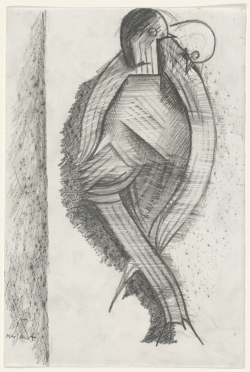
Max Ernst, Conjugal Diamonds, 1925, frottage in graphite, National Gallery of Art, Gift of Helen Porter and James T. Dyke
Befitting the surrealists’ love of revelatory slips of the tongue and the hand, this portrait of Max Ernst came together accidentally while Sommer was tidying his studio. To make it, the photographer superimposed two negatives so that Ernst’s skin took on the texture of a water-stained concrete wall.[2] The result was a nod to the look of frottage, the drawing technique Ernst used to create such works as Conjugal Diamonds. The photograph also captures Ernst’s bird-like features and echoes the surrealist’s own depictions of himself as his alter-ego, a bird named Loplop. Indeed, according to Sommer’s recollections, Ernst saw this as the definitive portrait of himself.[3]
Made in 1925, the drawing at left dates to the year when Max Ernst first invented frottage—a technique of rubbing graphite on paper laid over a textured surface.[4] Ernst used the resulting “found” textures as the building blocks for his images, many of which depict fantastical creatures.
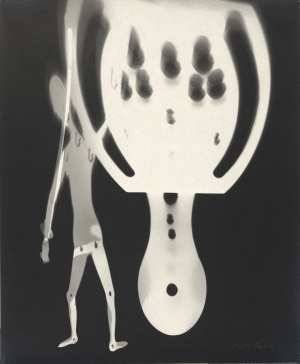
Man Ray, Manikins, 1924, gelatin silver print, Yale University Art Gallery, Gift of Collection Société Anonyme, © Man Ray Trust/ADAGP 2013
Man Ray
Sommer met Man Ray (1890–1976) in 1941 at the same party in the Hollywood Hills where he met Max Ernst, and afterward the two men continued to follow each other’s work from afar. Sommer’s friendship with Ernst, moreover, offered him in-depth knowledge about the entire surrealist circle, including Ernst’s close friend Man Ray, whom Sommer would laud years later as “a pioneer in the inter-relationships between the arts.”[5]
Of all the surrealists, Man Ray experimented with photography the most, manipulating “straight” photographs (i.e., those that try to depict their subject matter with utmost objectivity) and pioneering techniques that included composite printing, solarization, and the making of Rayographs— unique prints made by placing objects directly on sensitized paper and exposing them to light. Man Ray had named his cameraless photograms after himself upon discovering this photographic process accidentally in the darkroom in 1922.[6] Though Sommer never made photograms himself, he did make photographs that are strikingly similar to some of Man Ray’s pictures in the way they distort the scale, modify the shape, and heighten the texture of familiar objects to create strange new scenes and creatures. Sommer’s works that best demonstrate these shared interests appear in the Found Objects section of this feature.
In the 1970s, Sommer started to write extensively about aesthetics, putting into words ideas that he had been exploring through his visual art for over three decades. In his texts, he frequently stressed the importance of interrelationships between the familiar and the new in his art. “The world is not a world of cleavages, it is a world of bonds,” he wrote, arguing that one can only transform into images those things to which one had already become attuned and attentive.[6] He also articulated a nuanced understanding of the role of borrowing in the creative process: “We owe much to our sources and should not be afraid to borrow,” he wrote. “What we learn from a work of art is renewed in the future. The right to this exchange is earned by dedication. . . . The inspiration and quality with which these sources reappear is the work of art.”[7]
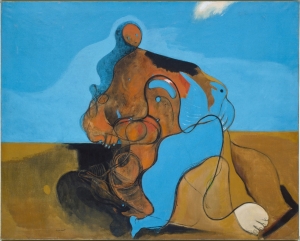
Max Ernst, The Kiss (Le baiser), 1927, oil on canvas, 50 3/4 x 63 1/2 inches (129 x 161.2 cm), The Solomon R. Guggenheim Foundation, Peggy Guggenheim Collection, Venice, 1976, 76.2553.71, © 2013 Artists Rights Society (ARS), New York / ADAGP, Paris
Sommer’s singularity often lies in the way he links borrowings from otherwise disparate sources to produce new insights. The visual resonances of the biomorphic forms found in Ernst’sThe Kiss, Weston’s Sandstone Concretion, Salton Sea, and Sommer’s Virgin and Child with St. Anne and the Infant St. John reveal how a shared formal vocabulary can be put to widely varying uses.
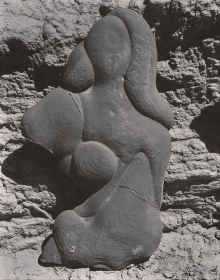
Edward Weston, Sandstone Concretion, Salton Sea, 1937, gelatin silver print, Collection Center for Creative Photography.
© 1981 Center for Creative Photography, Arizona Board of Regents.
Ernst’s painting playfully confuses the traditional painterly division of foreground and background to hide its eroticism in plain sight. Weston’s photograph accentuates the beauty of forms found in nature.
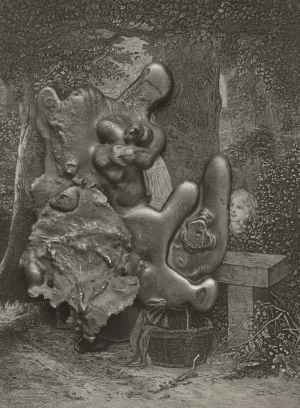
Frederick Sommer, Virgin and Child with St. Anne and the Infant St. John, 1966, gelatin silver print, National Gallery of Art, Gift of Frederick Sommer
Sommer’s photograph encourages us to see a meaningful shape in something as accidental and uncontrollable as a piece of molten metal, which uncannily resembles the outline of a group of figures in a famous Leonardo da Vinci painting when placed atop an illustration from a children’s book. The photograph makes the connection between the blob and the masterpiece, but does not explain it, bearing out Sommer’s assertion that “poetic logic is the sensuous apprehension of what we do not yet understand in the presence of reality.”[8] The poetic logic of this image allows a startling connection to emerge by combining a beautiful abstract form with a surrealist double-take.
[1] Quoted in Lyons and Cox, The Art of Frederick Sommer, 226.
[2] Mia Fineman, Faking It: Manipulated Photography before Photoshop (New York and New Haven, CT, 2012), 176.
[3] See Naomi Lyons audio interview in “The Photographs of Frederick Sommer: A Centennial Tribute.” The J. Paul Getty Museum, 2005.
[4] Werner Spies and Sabine Rewald, eds., Max Ernst: A Retrospective (New York and New Haven, CT, 2005), 286.
[5] Quoted in Philadelphia College of Art, Frederick Sommer, 20.
[6] Ian Walker, “Man Ray and the Rayograph,” Art and Artists 10:1 (April 1975): 40–42. It is worth noting that the making of photograms is as old as photography itself. Some of the earliest examples were made by William Henry Fox Talbot, the inventor and photographer who promoted the new medium in Great Britain from the 1840s.
[7] Frederick Sommer, “A Talk Given at the Art Institute of Chicago,” originally delivered in 1970, revised in 1983, reprinted in Sommer, Sommer. Words, 40. In an earlier published version of this talk, the quote read, “The world is not a world of cleavages at all; the world is a world of bonds.” See Peninah R. Y. Petruck, ed., The Camera Viewed: Writings on Twentieth-Century Photography, vol. 2 (New York, 1979), 56.
[8] Frederick Sommer, “Art and Aesthetics,” originally written in 1982, reprinted in Sommer, Sommer. Words, 9.
[9] Frederick Sommer, “The Poetic Logic of Art and Aesthetics,” originally written in 1972, reprinted in Sommer, Sommer. Words, 39.





